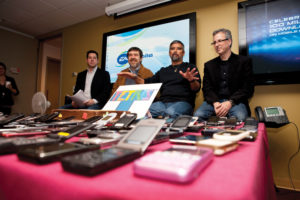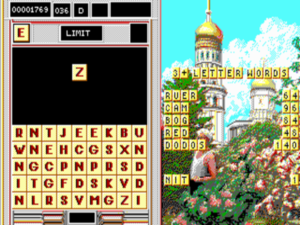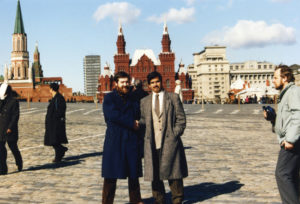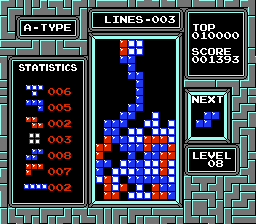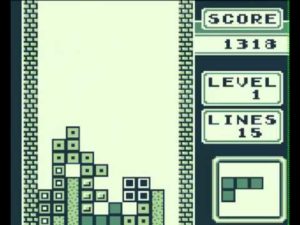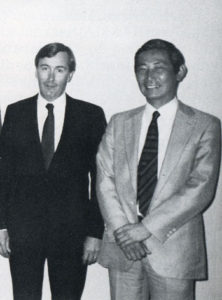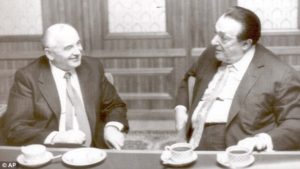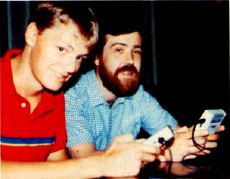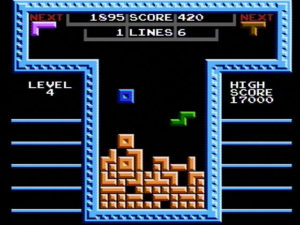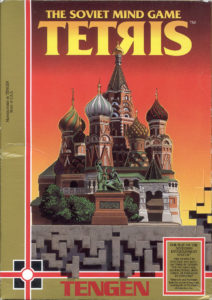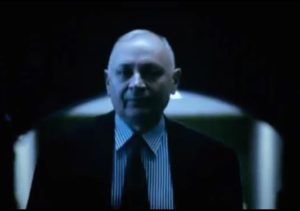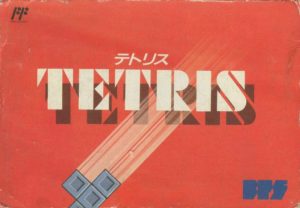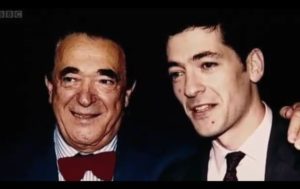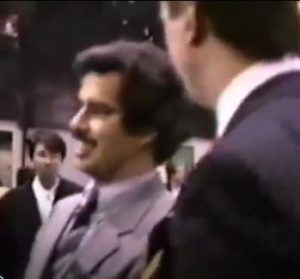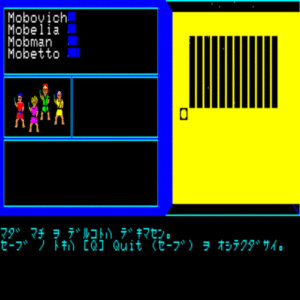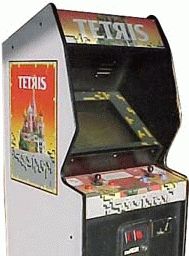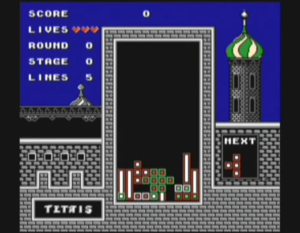As the dust settled from the battle over Tetris and a river of money started flowing back to the Soviet Union, the Soviet Academy of Sciences made a generous offer to Alexey Pajitnov. In acknowledgment of his service to the state, they told him, they would buy him an IBM PC/AT — an obsolete computer in Western terms but one much better than the equipment Pajitnov was used to. This would be the only tangible remuneration he would ever receive from them for making the most popular videogame in the history of the world.
But the Soviet Union was changing rapidly, and Pajitnov intended to change with it. He formed a little for-profit company — such a thing was now allowed in the Soviet Union — called Dialog with a number of his old friends and colleagues from the Moscow Computer Center, among them his friendly competitor in game-making, Dmitry Pavlovsky, and the first of many psychologists who would be fascinated by the Tetris Effect, Vladimir Pokhilko. The name of the company was largely a reflection of a pet project cooked up by Pajitnov and Pokhilko, a sort of cross between Eliza and Alter Ego with the tentative name of Biographer. “This kind of software can help you to understand your life and change it,” Pajitnov believed. “This will help people. This is what I would call a ‘constructive game.'” Such a game would be, needless to say, a dramatic departure from Tetris, demanding far more time to develop than had that exercise in elegant minimalism.
In the meantime, though, Tetris was huge. Henk Rogers, now well-established as Pajitnov’s mentor in the videogame business, advised him strongly to make a sequel, and to do it soon — for if you don’t strike soon, he told him, someone else will. Pajitnov therefore came up with a game he called Welltris, a three-dimensional Tetris in which the shapes fell down into a “well” — thus the name — which the player viewed from above. While Welltris lacked the immediate, obvious appeal of Tetris, some players would come to love it for its subtle complexity. Pajitnov had no problem selling it to Spectrum Holobyte in North America, who despite their affiliation with the hated Mirrorsoft had managed by dint of luck and cleverness to remain in his good graces. In Europe, the game was picked up by the French publisher Infogrames. It was released for personal computers on both continents before 1989 was through.
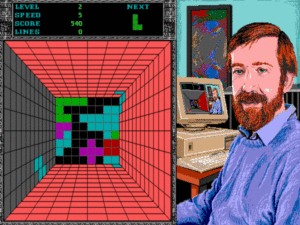
Befitting his growing celebrity status, Alexey Pajitnov himself featured in the background graphics of Welltris.
Pajitnov greeted a new year and a new decade by taking his first trip to the United States. Paid for by Spectrum Holobyte, whose resources were limited, it was an oddly austere promotional junket for the designer of the most popular videogame in the world. He made the trip alone but for a translator to help out with his still-broken English. His first stop was Las Vegas, for the Winter Consumer Electronics Show — quite the introduction to American excess! He sat gaping in wonder at the food piled in mounds before him at the hotel’s $3.69 all-you-can-eat buffet, flicked his “I Love Vegas” cigarette lighter, and remarked, “So this is a typical American city.” After Vegas, he traveled around the country in what a Boston Globe reporter described as “almost an underground manner,” “apartment to apartment, computer friend to computer friend.” But he was hardly a man of expensive tastes anyway; out of all the food he ate on the trip, it was Kentucky Fried Chicken he liked best.
Spectrum Holobyte did spring for a lavish press reception in San Francisco’s St. Francis Hotel. The day after that event, he made time for a “U.S./Soviet Personal Computer Seminar” at San Francisco State University out of his desire to “grow up the game life in Moscow. I want to help, with advice.” He visited Minoru Arakawa and Howard Lincoln at Nintendo of America’s headquarters in Seattle; got to see in person paintings at the Museum of Modern Art and the Metropolitan in New York which he’d known only from the books in his parents’ library; visited MIT’s Media Lab to view cutting-edge research into virtual reality, trying not to compare the technology that surrounded him there too closely to the spartan desk he had to share with others back at the Moscow Computer Center. And between all these glimpses of American life, he gave interview after interview to an endless stream of journalists eager to get their whack at one of the great current human-interest stories. He made time for everyone, from the slick reporters from the major newspapers and magazines to the scruffy nerds from the smallest of the trade journals. One and all treated him as living proof of the changing times, a symbol of the links that were being forged between East and West in this new, post-Cold War order.
His odyssey wound up in Hawaii with Henk Rogers, swimming and kayaking and drinking mai tais. The two friends were a long, long way from the gray streets of Moscow where they had met, but the bond they had forged there endured. Over drinks one gorgeous starlit evening, Rogers asked Pajitnov if he would be interested in leaving the Soviet Union permanently to work on games in the West. Torn between the wonders he had just seen and everyone’s natural love for the place he came from, he could only shrug for now: “I do not have an answer for that question.”
Rogers had had good reason for asking it. Ever ambitious, he had used the first influx of cash from Tetris to establish a new branch of Bullet-Proof Software in Seattle, conveniently close to Nintendo of America’s headquarters. Broadly speaking, his intention was to do in the North American Nintendo market what he had been doing in Japan: find games in other countries and on other platforms that would work well on the Nintendo Entertainment System and/or the Game Boy, license the rights, and port them over. His first big North American release, a puzzle game called Pipe Dream that had already been a hit on home computers in Europe, would do very well on the NES and Game Boy as well.
Yet Rogers was also eager to do original games with Pajitnov. He had passed on Welltris, whose 3D graphics were a little more than the Nintendo machines were realistically capable of, but kept cajoling Pajitnov to come up with yet another, more Nintendo-friendly Tetris variant. The result was Hatris, where the falling shapes of Tetris were replaced with falling hats which had to be stacked atop one another according to style. Although it presaged the later craze for matching games in the casual-game market even more obviously than had Tetris, it wasn’t all that great a game in its own right. Even on his American publicity tour, when it was still in the works, Pajitnov described it without a lot of enthusiasm. The sub-genre he had created was already in danger of being run into the ground.
But the industry, inevitably, was just getting started. The next several years would bring heaps more variations on the Tetris template, a few of them crediting their design fully to Pajitnov, some of them crediting him more vaguely for the “concept,” some of them not crediting him at all. Some ran on computers, some ran on consoles from Nintendo and others. Some were very playable, some less so. Personally, I have a soft spot for 1991’s Wordtris, a game designed by two of Pajitnov’s Russian partners at Dialog where you have to construct words, Scrabble-style, out of falling letters. In addition to its other merits, it became another casual pioneer, this time of the sub-genre of word-construction games. But then, I’m far better at verbal puzzles than spatial ones, so my preference for the wordy Wordtris should perhaps be taken with a grain of salt.
Despite all the industry’s enthusiasm for Tetris-like games, Pajitnov and Pokhilko’s plans for an Eliza killer came to naught. Publishers were always willing to use Pajitnov’s name to try to sell one more falling-something game, but didn’t think it had much value attached to high-concept fare like Biographer.
In 1991, Pajitnov finally answered in the affirmative the question Rogers had posed to him on that evening in Hawaii; he and his family immigrated to San Francisco. Cutting ties with Dialog back in a Soviet Union that was soon to be known simply as Russia again, he formed a design partnership with Pokhilko, who soon joined him in the United States. Over the next several years, the two created a variety of simple puzzle games, some more and some less Tetris-like, for various publishers, along with at least one truly outré concept, the meditative, non-competitive “aquarium simulator” El-Fish.
Meanwhile the times were continuing to change back in Russia, as piece after piece of the state-owned economy was privatized. Among the entities that were spun off as independent businesses was ELORG. Nikolai Belikov, savvy as ever, ended his career in the bureaucracy by becoming the owner and chief executive of the new ELORG LLC.
Henk Rogers had all but promised Pajitnov shortly after they had met in Moscow that, although he might not be able to secure a Tetris royalty for him right away, he would take care of him in the long run. He had indeed looked out for him ever since — and now he was about to deliver the ultimate prize. He came to Belikov with a proposal. Belikov still didn’t know much about the videogame business, he said, but he did. In return for a 50 percent stake in Tetris, he would take over the management of what was by now not so much a videogame as a global brand. Belikov agreed, and Rogers and Pajitnov together formed The Tetris Company in 1996 to manage the Western stake. And so at last Alexey Pajitnov started getting paid — and paid very well at that — for his signature creation.
For Rogers, protecting Tetris represented an almost unique challenge. More than virtually any other videogame, the genius of Tetris is in the concept; the implementation is trivial in comparison, manageable by any reasonably competent programmer within a few weeks. And, indeed, the public-domain and shareware software communities in the West had been flooded with clones and variants almost from the moment the game had first appeared on Western computers in 1988, just as had been the land behind the Iron Curtain in the years prior to that. No more, said Rogers. He hired a team of lawyers to go after anyone and everyone who made a game of falling somethings without the authorization of The Tetris Company, attacking with equal prejudice those who tried to sell their versions and those — often beginning game programmers who were merely proud to show off their first creations — who shared them for free. His efforts created no small uproar on the Internet of the late 1990s, leaving him to take plenty of heat as, as he once put it himself, “the jerk behind The Tetris Company.”
To this day, the bulk of The Tetris Company’s time and energy is devoted to the relentless policing of their intellectual property. As one would expect, Rogers and company have tended to draw the broadest possible line around what constitutes an infringing Tetris clone. The location of the actual line between legality and illegality, however, remains curiously unresolved. The Tetris Company has always had a lot of money and a lot of lawyers to hand, and no one has ever dared engage them in a legal battle to the death over the issue.
In addition to managing The Tetris Company, Henk Rogers continued to run Bullet-Proof Software throughout the decade of the 1990s. The first half of that period was marked by a number of successful non-Tetris titles, such as the aforementioned Pipe Dream, but over time Bullet-Proof increasingly dedicated themselves to churning out permutation after permutation on a game that many would argue had been born perfect: Tetris 2, Tetris Blast, V-Tetris, Tetris S, Tetris 4D. By decade’s end, they were running out of names. Screw it, they said in 1998, we’ll just call the next Tetris… The Next Tetris.
Bullet-Proof closed up shop shortly after that game, but Rogers formed Blue Lava Wireless in 2002 to make games for the first wave of feature phones. Their most successful titles by far were… you guessed it, mobile versions of Tetris. Indeed, the convergence of Tetris with mobile phones drove a second boom that proved just as profitable as the first, Game Boy-driven wave of mobile success.
Having long since sold Blue Lava, Rogers lives the good life today in his first geographical love of Hawaii, running the Blue Planet Foundation, which has the laudable goal of ending the use of carbon-based fuels in Hawaii and eventually all over the world; he also oversees a commercial spinoff of the foundation’s research called Blue Planet Energy. He’s still married to the girl who tempted him to move to Japan all those years ago. And yes, he’s a very, very rich man, still making millions every year from Tetris.
Alexey Pajitnov has continued to kick around the games industry, plying his stock-in-trade as a designer of simple but (hopefully) addictive puzzle games and enjoying his modest celebrity as the man who made Tetris. He spent several years at Microsoft, where he was responsible for titles like The Microsoft Puzzle Collection and Pandora’s Box; some of the puzzles found therein were new, but others were developed contemporaneously with the original Tetris during all those long days and nights at the Moscow Computer Center. He’s slowed down a bit since 2000, but keeps his hand in with an occasional mobile game, which his reputation is always sufficient to see published. In light of his ongoing design work, it was perhaps a bit unkind of a 2012 IGN article to call him one of the games industry’s “one-hit wonders.” Still, Tetris was so massively important that it was all but an inevitability that it would overshadow every other aspect of his career. Pajitnov, for his part, seems to have made his peace with that, humoring the wide-eyed reporters who continue to show up to interview him at his current home near Seattle. It may have taken Tetris a long time to pay off for him, but he can have no complaints about the rewards it brings him today: he is, like Henk Rogers, very, very rich. The two men remain close friends as well as business partners in The Tetris Company; the warm relationship forged over vodka on that cold Moscow night back in February of 1989 continues to endure.
Nikolai Belikov, the most unlikely person ever to become a millionaire thanks to videogames, finally cashed in his Tetris chips in 2005, selling his stake in the game to The Tetris Company for $15 million. Doing business in his country remained as complicated as ever at that time. The only difference was that Belikov now had to fear the Russian Mafia finding out about his windfall rather than the KGB and the other entrenched forces of the old communist system. In an episode that had much the same spy-movie flavor as the original Tetris negotiations, Belikov and Rogers signed the deal and exchanged funds in Panama. The former then went back home to Moscow to enjoy a retirement worthy of an oligarch.
The other people Alexey Pajitnov left behind in Russia weren’t quite so fortunate. Dialog, the company he had helped found there before emigrating, collapsed soon after the departure of their star designer. And with the end of Dialog ended the game-design career of Dmitry Pavlovsky, who went back to other computer-science pursuits.
Vadim Gerasimov, the third member of the little game-making collective that had spawned Tetris, had parted ways with Pajitnov even before the brief-lived Dialog experiment. The most idealistic hacker in the Russian camp, the circus that sprang up around the Tetris rights had never sat well with him. He claims that at some point after ELORG got involved in the negotiations Pajitnov came to him with a paper to sign. It stated, according to him, “that I agree to only claim porting Tetris to the PC, agree to give Pajitnov the right to handle all business arrangements, and refuse any rewards related to Tetris. I did not entirely agree with the content, but I trusted Alexey and signed the paper anyway.” Gerasimov had been given credit right after Pajitnov himself as the “original programmer” of Tetris in the Mirrorsoft and Spectrum Holobyte versions, but by the time the Nintendo versions appeared his name had been scrubbed from the game. To my knowledge, he never made any money at all from writing the first version of Tetris to reach beyond the Iron Curtain. While I hesitate to condemn Pajitnov or anyone else too roundly for that state of affairs — after all, even Pajitnov himself wasn’t paid for many years for his game — it does strike me as unfortunate that Gerasimov was allowed, whether consciously or accidentally, so completely to slip through the cracks. Had he not lent Pajitnov his talents, it’s highly unlikely that the game would ever have become more than a curiosity enjoyed by a handful of people in and around the Moscow Computer Center.
Gerasimov does evince a tinge of bitterness when he speaks about the subject, but, to his credit, he hasn’t let it consume his life. Instead he’s made a fine career for himself, immigrating to the United States, earning a doctorate from MIT, and finally winding up in Australia, where he works for Google today as a software engineer. He claims not to agree with The Tetris Company’s policy of so zealously protecting the property — although his position should perhaps be considered with a certain skepticism in light of the fact that he has never been in a position to benefit from that protection.
It was Pajitnov’s good friend and frequent design partner Vladimir Pokhilko who came to by far the worst end among the Russians who were there to witness Tetris‘s birth. Having cut his business ties with Pajitnov after the latter took a staff job with Microsoft in 1996, he tried to make a go of it in Silicon Valley, but bet on all the wrong horses. Beset by financial problems and rumored entanglements with the Russian Mafia, in 1998 he murdered his wife and son with a hammer and a hunting knife, then cut his own throat. His good-natured comment to his buddy at the Moscow Computer Center in 1984 — “I can’t live with your Tetris anymore!” — suddenly took on a different dimension in the aftermath. Pajitnov, so garrulous on most subjects, clams up when the topic turns to Pokhilko, the old friend who was obviously hiding a profound darkness behind his cheerful smile. “We [were] always friends, colleagues, and partners with good and warm relations,” he says, and leaves it at that — as shall we.
Pokhilko wasn’t the only character in the Tetris story to come to a bad end. Sometime during the early morning of November 5, 1991, Robert Maxwell jumped or fell off the deck of his luxury yacht into the sea near the Canary Islands. His body was discovered by a passing fishing boat the next day.
When executors and regulators began to look closely at Maxwell’s personal finances and those of his vaunted publishing empire in the aftermath of his death, what they found appalled them. He had racked up more than $3 billion in debts, and had been stealing from his employees’ pension funds and making countless other illegal transactions in order to shore up both his business interests and his own lavish lifestyle. Pathologists hadn’t been able to agree on a definite cause of death after his battered body was recovered. In light of this, and in light of his political and financial entanglements all over the world, not to mention the accusations of espionage that have occasionally dogged him, conspiracy theories abound about his fate. One suspects, however, that the more prosaic explanations are the more likely: either he deliberately threw himself into the water to escape the financial reckoning he knew was coming, or, being grossly overweight, he had a heart attack while taking in the view and simply fell into the water. There is, however, one other oddity about the whole thing to reckon with: his body was completely naked when it was recovered. It’s highly doubtful that the mystery of Robert Maxwell’s death will ever be solved beyond a shadow of doubt.
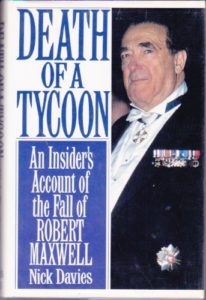
The strange circumstances of Robert Maxwell’s death caused a sensation in the British tabloid press.
In the wake of the Maxwell empire’s collapse, Kevin Maxwell filed for the biggest personal bankruptcy in British history, writing off more than $1 billion in debts. He was taken to trial for conspiracy to commit fraud for his involvement with his father’s house of cards, but was acquitted. His business record since has been checkered, encompassing another huge bankruptcy and repeated accusations of malfeasance of various stripes.
Like most of Robert Maxwell’s properties, Mirrorsoft was sold off in the scandal that followed his death. The operation wound up in the hands of Acclaim Entertainment, but the name disappeared forever.
Over in the United States, Spectrum Holobyte managed to live considerably longer. Phil Adam and Gilman Louie, the partners who had long run the publisher, pulled together enough venture capital in the midst of the Maxwell empire’s collapse to buy their complete independence. They then went on another buying spree as the merry 1990s got going in earnest, picking up both the computer-game publisher MicroProse and the American division of Henk Rogers’s Bullet-Proof Software in 1993. Combined with the good relations they enjoyed with Rogers and Pajitnov, the latter purchase seemingly left them well-positioned to continue to exploit Tetris for years to come. But they had extended themselves too far too quickly, picking up a mountain of debt in the process. Caught out in between the first and the second great Tetris booms, they were never quite able to turn the corner into reliable profitability. Hasbro Interactive bought the troubled company in 1998, and the name of Spectrum Holobyte also vanished into history.
Robert Stein lost his rights to Tetris on personal computers in 1990, when ELORG terminated his license due to his ongoing failure to pay them in a timely manner. Stein did cite an excuse for his tardiness this time, claiming that Mirrorsoft had simply stopped paying him for their sub-license altogether amid the brouhaha of 1989. Since Spectrum Holobyte was paying their royalties to Mirrorsoft, who were supposed to then pass them on to Stein, such a refusal would have meant that Stein himself would have received nothing at all to pass on to the Russians. Regardless of the full truth of the matter, Stein was forced out of the picture, and Spectrum Holobyte negotiated their own license directly with ELORG in order to continue making their version of Tetris.
Stein lost his last remaining Tetris deal, for the arcade rights, in 1992. Once again, ELORG cited non-payment as their reason for terminating the contract, and once again Stein claimed that his sub-licensee — this time Atari Games — wasn’t paying him.
Years before this event, Stein’s little company Andromeda Software, thoroughly unequipped to compete in the evolving international videogame market, had ceased to exist as anything other than a paper entity. With the termination of his last ELORG deal ended his time in games. I don’t know what he’s been doing in the years since, but he is alive and apparently well.

A recent still of Robert Stein from the documentary Moleman 4.
To this day, however, Stein remains deeply embittered against virtually every other character in the story of Tetris. His own narrative is at odds with that of the other principals on a number of key points. He confesses only to naiveté and perhaps the occasional bout of carelessness, never to deliberate wrongdoing. In his telling, the story of February and March of 1989 is that of a premeditated conspiracy, orchestrated by Henk Rogers, to steal Tetris away from him. While he admits to having earned about $150,000 to $200,000 from Tetris — no mean total in the context of most videogames of its era — he’s clearly haunted by all the tens of millions earned by Rogers, Pajitnov, and Belikov. “Tetris made enemies out of friends and corrupted people left, right, and center,” he says.
The war between the two Ataris and Nintendo raged on long after the issue of the Tetris rights was decided in November of 1989.
In May of 1989, Atari Games had launched still another lawsuit against Nintendo, this time alleging them to have violated their patent on an “apparatus for scrolling a video display” from 1979. Meanwhile Nintendo continued to put the squeeze on Atari at retail, threatening to cut off stores who dared to stock the Tengen games. Atari’s Dan Van Elderen claims that eventually all fifteen of the largest retail chains in the country dropped Tengen in the face of such pressure.
Atari found a friendly ear for their tale of woe in United States Congressman Dennis Eckart. The Democrat from Ohio was the chairman of a subcommittee focused on antitrust enforcement, and he was already inquiring into Nintendo’s business practices when he was contacted by Van Elderen. Van Elderen and other Atari executives became star witnesses in building the case for an official government investigation into Nintendo, while Eckart never even contacted anyone from the opposing camp to ask for their side of the story. On December 7, 1989, the 48th anniversary of the attack on Pearl Harbor — the timing struck very few as coincidental — Eckart held a press conference to announce his recommendation that the Justice Department launch a probe of Nintendo’s role in the videogame market. As Howard Lincoln would later note, the press conference couldn’t have favored Atari’s position more had the latter written the script — which, in light of the cozy relationship that had sprung up between Eckart and Atari, there was grounds to suspect they had. The Justice Department soon handed the case to the Federal Trade Commission.
While the FTC investigated, Eckart continued to speak out against the Menace from Japan, blending long-established generational hysteria against videogames in general with Japophobia. Like many in the software industry, his greatest fear was that Nintendo would turn the NES into a real home computer, as they were trying to do to the Famicom in Japan, and use it to take over the entire market for consumer software. Think of the children, he thundered: “How did they [Nintendo] get in American homes? They enticed their way in through our children’s hearts. If you turn a toy into a computer, what’s the next step?”
Under mounting pressure from several sides, Nintendo eased their licensing conditions somewhat on October 22, 1990, allowing some licensees to begin manufacturing their own game cartridges. They also dropped the provisions from their standard licensing agreements that restricted their licensees from releasing their games on rival platforms. Many publishers would admit privately that the removal of this specific language from the contract changed little in actuality — “I’m not going to make games for competing systems because we know that Nintendo would get even, one way or another,” said one — but it did do much to nullify the primary charge in Jack Tramiel’s Atari Corporation’s case against Nintendo: that not allowing licensees to release a game on a rival platform for two years after its appearance on the NES constituted an abuse of monopoly. Some suspected that the changes at Nintendo had been the result of a deal with the FTC which allowed them to avoid some charges of engaging in anti-competitive practices.
Although Nintendo was clearly moderating some of their stances in response to recent developments, Atari Games still couldn’t manage to get a win in Judge Fern Smith’s courtroom. On the contrary: on March 27, 1991, she handed them another devastating defeat. A forensic study of the code used in the lockout-defeat mechanism employed by the Tengen cartridges having shown it to be virtually identical to Nintendo’s own, Judge Smith excoriated Atari for their actions in words that left no doubt about her opinion of their business ethics. She certainly made no effort to sugarcoat her verbiage: “Atari lied to the Copyright Office in order to obtain the copyrighted program,” she bluntly wrote. After having killed the Tengen Tetris fifteen months before, she now ordered all unauthorized Tengen games for the NES to be pulled from the market.
On April 10, 1991, the FTC announced that they had charged Nintendo with price-fixing in light of the latter’s policy of demanding that retailers not discount their products. But, anxious to avoid another ugly public legal battle, Nintendo had agreed to a settlement which required them to discontinue the policy in question, to pay $4.75 million to cover the government’s administrative costs in conducting the investigation, and to send consumers who the government claimed had been negatively affected a $5 coupon good for future Nintendo purchases. And with that, the FTC’s Nintendo probe was effectively finished. Everyone agreed that Nintendo had gotten off rather shockingly easy in being allowed to turn what should have been the negative press of a major judgment against them into what amounted to a new sales promotion. It almost seemed like someone at the FTC had a soft spot for them. Both Ataris blasted the easy treatment of Nintendo in the press, indelicately implying that something underhanded must be going on between Nintendo and the FTC.
But brighter news for the Atari camp did come the very next day. Atari Games had bitterly contested Judge Smith’s injunction stating that they couldn’t sell their Tengen games on the NES unless and until their appeal of her most recent ruling was concluded in their favor. They claimed the injunction could very well drive them out of business before that day arrived, making their ongoing appeal moot. On April 11, the appeals court agreed to give them back their right to sell the Tengen games while the legal proceedings ground on.
Whatever the situation in court, the two Ataris could feel fairly confident that they were at the very least holding their own in the public-relations war. In January of 1992, Michael Crichton summed up the mood of many inside and outside the American government with his novel Rising Sun. A thinly disguised polemic against Japan — Crichton himself described the book as a “wake-up call” to his country about the Japanese threat — it centers on a fictional corporation called Nakamoto whose mysterious leader sits far away in Japan at the center of a web of collusion and corruption. It was hard not to see the parallels with Nintendo’s greatly-feared-but-seldom-seen president Hiroshi Yamauchi. Price-fixing and other forms of collusion are “normal procedure in Japan,” says one of Crichton’s characters. “Collusive agreements are the way things are done.”
Just months after the publication of the novel, Yamauchi confirmed all of its worst insinuations in the eyes of some when he bought the Seattle Mariners baseball team. The Japanese, it seemed, were taking over even the Great American Pastime. What was next, Mom and apple pie? Major League Baseball approved the sale only on the condition that the day-to-day management of the team remain in American hands.
Hoping to capitalize on the political sentiment that so often painted Nintendo as a dangerous foreign invader, Tramiel’s Atari Corporation elected to take their $250 million lawsuit against Nintendo to a jury trial. But whatever abuses Nintendo may have committed, they had been smart enough not to give Atari any smoking guns in the form of written documentation of their more questionable policies. When Minoru Arakawa took the stand, he faced a barrage of aggressive accusations from Atari’s lawyers.
Isn’t it a fact that if Atari or Sega was also being carried, the salesman would go in and say they won’t be able to carry Nintendo?
Did Nintendo ever tell any licensee that they could only make games for Nintendo?
Did Nintendo ever tell them, the licensees, that if they put their games on any other system they would be penalized?
That Nintendo would reduce their allocation of chips during the chip shortage?
Cancel trade-show space?
Any threats to prevent them from making games for other home-videogame systems?
To every question, Arakawa gave a one-syllable answer: “No.”
On May 1, 1992, the verdict came back. The jury did acknowledge that Nintendo had enjoyed a de facto monopoly over the American console market at the time Atari had filed their suit, but just having a monopoly is not illegal in itself. The jury found that Atari hadn’t managed to prove that Nintendo had abused their monopoly power. Atari Corporation would elect not to appeal the verdict.
On September 10, 1992, Atari Games lost their appeal to Judge Smith’s ruling against them of the previous year, and her overturned injunction against them went into permanent effect. All Tengen games on Nintendo’s platforms were to be pulled from store shelves and destroyed, effective immediately. Tengen and Nintendo had been parted forever.
With these last two rulings, the war entered the mopping-up phase, the final result all but a foregone conclusion. In 1990, the delicate stock-balancing act that had allowed Hideyuki Nakajima to run Atari Games as an independent entity had collapsed, and Time Warner had assumed control. The latter was skeptical from the beginning of this war that felt like it had at least as much to do with pride and legacy as it did with sound business strategy. Following these latest setbacks, they pressed Nakajima hard to cut his losses and settle the remaining legal issues. Atari Games and Nintendo announced a closed settlement agreement on March 24, 1994, that put the last of the litigation to bed, presumably at the cost of some number of millions from Atari.
Shortly thereafter, Atari Games ceased to exist under that name. On April 11, 1994, Time Warner went through a restructuring which saw Atari and Tengen subsumed into the preexisting subsidiary Time Warner Interactive. With the arcade market slowly dying and Nintendo certainly not likely to let them back onto their platforms anytime soon, the storied name of Atari had become a liability rather than an asset.
Atari Corporation came to a similarly dispiriting end. After years of creeping irrelevancy brought on by the slow decline of their ST line of computers and the more dramatic failure of the Atari Jaguar, a quixotic last-ditch effort to launch a game console to compete directly with Nintendo, the remnants of the company were scooped up by JTS Storage, a maker of hard disks, on July 30, 1996. Thanks to the financial contortions that were used to bring off the deal, the transaction was counter-intuitively recorded as an acquisition of JTS by Atari, but there was no doubt on the scene about who was really acquiring whom. Like Time Warner, JTS saw little remaining value to the Atari name; they had acquired Atari Corporation for nothing more nor less than a pile of cold hard cash the company had recently collected after winning a patent-infringement judgment against Sega, not in the hope of making Atari mean something again to a new generation of gamers for whom the name’s glory days were ancient history. But the money didn’t do them much good; JTS went bankrupt in 1999.
In a previous article, I called the war between the two Ataris and Nintendo the past of videogames versus their future. As we can now see, that description is almost literally true. The two Ataris could perhaps console themselves that they had forced some changes in Nintendo’s behavior, but they had paid a Pyrrhic price for those modest tactical victories. After the war was over, both Ataris died while Nintendo thrived. Winning the war so utterly became one of the proudest achievements of Howard Lincoln, that unapologetically vindictive master strategist. “Lincoln’s motto was ‘fuck with us and we will destroy you,'” said one of Nintendo’s lawyers. “Otherwise he’s a really nice guy.”
Yet the full import of the war extended far beyond its importance to the individual combatants: it marked a watershed moment for the way that software is sold. Buried in the text of Judge Smith’s 1991 ruling against Atari Games was the statement that legitimized the future not just of console-based videogames but of much of the rest of the consumer-software market. Irrespective of the shady methods Atari had employed to violate Nintendo’s patent in the case at hand, Judge Smith affirmed that Nintendo did have the abstract right to “exclude others and reserve to itself, if it chooses” complete control of the Nintendo cartridge market. This statement essentially reversed an established precedent, dating back to an antitrust case that was decided against IBM in 1969, that a hardware manufacturer could not decide what software was allowed to run on their machines. With the legal cover Judge Smith provided, what had once been shocking enough to set most of the American software industry up in arms soon became routine. Every successful console that would follow the NES, from Nintendo or anyone else, would use the walled-garden model. Even more significantly, virtually every significant new software market to arise in the future, such as the mobile-phone and tablet markets that thrive today, would also be a walled garden controlled by a single corporation. Today, the un-walled marketplace for personal-computer software has become the exception rather than the rule, a shambling ghost from the past which no corporation has yet been able to corral. And long may it shamble on, for it continues to provide a haven in interactive media for the experimental, the controversial, the iconoclastic, and the esoteric — all the things the walled gardens reject.
The anti-Japanese, anti-Nintendo sentiment in the country, which had threatened to reach xenophobic levels in some circles, gradually faded as the decade wore on and Nintendo lost some of their standing as the be-all, end-all in videogames. Their much-feared strategy of using the NES as a Trojan Horse to take over all of consumer computing never really got off the ground. The enhancements that turned the Famicom into a full-fledged computer had never done tremendously well in Japan, and the Nintendo Network there turned into one of the company’s rare outright failures, never getting beyond the tens of thousands of subscribers. A survey found that the biggest source of consumer resistance to the idea was, ironically, Nintendo’s established reputation in videogames. People just weren’t excited about using what they thought of as their children’s toys to manage their stock portfolios. In light of these setbacks in Japan, Nintendo never introduced either the “computery” hardware enhancements they had tried on the Famicom or the Nintendo Network to North America. They instead elected to content themselves with their lot as the biggest company in videogames, much to the relief of the American software industry.
But even in the field of videogames, Nintendo wouldn’t stand alone for much longer. Sega had introduced their Genesis console in North America already at the end of 1989. Following a slow start, it eventually turned into a viable competitor for the aging NES. At mid-decade, Sony arrived with the PlayStation as a third major player in the game-console space. While both Sega and Sony adopted Nintendo’s walled-garden approach to software, one could no longer claim that videogaming writ large in North America lived by the whims of a single company. Yes, one could still be unhappy that all three popular console-sellers in the United States were Japanese — another successful born-in-America console wouldn’t arrive until the Microsoft Xbox in 2001 — but even that concern faded somewhat with the tech boom of the mid- and late 1990s. In this market, there was plenty of room for everyone, even the shifty-eyed foreigners.
Minoru Arakawa resigned as president of Nintendo of America in January of 2002. When not enjoying semi-retirement, he has since worked with Henk Rogers and Alexey Pajitnov on various projects related to Tetris.
Howard Lincoln was appointed CEO of the Seattle Mariners in 1999, signaling a scaling back in his involvement with Nintendo proper. He continued to run the team until 2016. His tenure produced no triumphs to compete with his great victory over the two Ataris; the team made the playoffs the first two years with him at the helm, but never again after that.
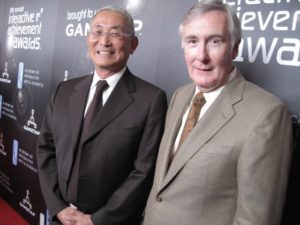
Minoru Arakawa and Howard Lincoln at the Interactive Achievement Awards in 2007, where they accepted lifetime-achievement awards.
In 2003, the North American arm of the French publisher Infogrames re-christened themselves Atari. Any hopes they might have had to revive the name’s glory days were, however, sadly disappointed. After years of lurching from crisis to crisis, the new Atari filed for Chapter 11 bankruptcy in 2013. Today a skeleton staff makes casino games under the name.
As for Nintendo… well, Nintendo remains Nintendo, of course. They’ve long since surpassed their old rival Atari to become the most iconic name in videogames. Once, parents would say that their children liked to “play Atari,” regardless of what name happened actually to be printed on the front of their game console. Now, they say their children like to “play Nintendo” — and, thanks largely to what Tetris first began, they’ll often say that they “play Nintendo” themselves. Nintendo has had ups and downs over the years, but have on the whole remained ridiculously successful thanks to the same old blending of strategic smarts with a deep well of ruthlessness ready to be employed when they judge the situation to call for it. Some variant or another of Tetris — usually more than one — has been a staple of every Nintendo machine since the NES and Game Boy.
And so we’re left with only one fate left to describe: that of the place where we began this journey, the Mirror World of the Soviet Union.
The dawn of the 1990s was an extraordinary time in the often fraught history of East/West relations. The opening of the Soviet Union brought with it the expectation that the world was witnessing the dawn of a new economic superpower even as a military superpower fell. Freed from the yoke of communism, Russia seemingly had everything going for it. It was a sprawling land bursting with natural resources, with an educated population eager to shed their isolation and become a part of the free world’s economic and political order. This was the period when Francis Fukuyama was writing The End of History, claiming that with the end of the Cold War free societies and free markets had won history’s argument, leaving humanity with nothing left to do but enjoy their fruits.
Few industries were more excited about jumping through the mirror and doing business in the lands beyond than the computer industry. As relations improved between West and East, the restrictions implemented by the Coordination Committee on Export Controls in the West were gradually eased. Already by 1988, it had been permitted to sell 16-bit microprocessors like the 80286 to the Soviet Union; by 1990, 32-bit processors like the 80386 were also allowed; by 1991, the restrictions as a whole were no more. Conferences and seminars sprung up, places for Western business executives to meet with former Eastern government bureaucrats newly thrust into the same role by their countries’ privatizing economies.
Of course, those Westerners peering eagerly through the mirror still had their work cut out for them in lots of ways. Most of the Eastern European economies were in complete disarray, with devalued currencies and thus little hard cash for buying Western products.
But where there’s a desire to do business, there’s usually a way. Some enterprising Western exporters resorted to complicated three-party deals. The would-be computer exporter would give their machines to an agent, who would send them on to Eastern Europe in exchange for raw goods. The agent would then sell the goods back in the West, and give the computer exporter a chunk of the profits. By 1992, an 80286-based PC in Russia cost about $1100. This was certainly better than the $17,000 one could have expected to pay for a shoddy Apple II clone nine years before, even if that kind of money would buy you a much more powerful 80386-based machine in the United States.
Issues of Byte magazine from the early 1990s buzz with excitement about the opportunities awaiting citizens of the Mirror World, not to mention those in the West who planned to guide them down the tricky paths of capitalism. “These are people who have felt useless — useless — all their lives!” said American business pundit Esther Dyson of the masses getting their first taste of freedom. “Do you know what it is like to feel useless all your life? Computers are turning many of these people into entrepreneurs. They are creating the entrepreneurs these countries need.”
And yet, sadly, the picture of a Russian entrepreneur in the popular imagination of the West of today is that of a mobster. Under the benighted stewardship of Boris Yeltsin, the high hopes for the Russia of the early 1990s gave way to the economic chaos of the mid- and late-decade years, paving the way for one Vladimir Putin. The new Russia proved unable to overcome the culture of corruption that had become so endemic during the old Soviet Union’s Brezhnev era.
I’m hardly qualified to provide a detailed analysis of why it has been so hard for Russia to escape its tragic past, any more than you are likely up for reading such a thing at the end of this already lengthy article. Since moving to Europe in 2009 and continuing to be subjected to my fellow Americans’ blinkered notions of what is “wrong” here and how it should be fixed, I’ve reluctantly concluded that the only way to really know a place may be to live there. So, in lieu of flaunting my ignorance on this subject I’ll just provide a few final anecdotes from my trip across Russia back in 2002.
- Driving around Moscow with several other backpackers and a guide we’d scraped together enough money to hire, I noticed some otherwise unmarked cars sporting flashing lights on the roof, of the sort that the driver can reach up through the window to set in place as she drives. There were a lot of these cars, all rushing about purposefully with lights undulating like mad. Was there really that much crime in the city? Or was some sort of emergency in progress? Weird if so, as the cars with the flashing lights by no means all seemed to be headed in the same direction. Curious about all these things, I finally asked our guide. “Oh, most of those cars aren’t actually police,” she said. “If you pay the right person, you can get a light like that for your personal car. Then you don’t have to stop at the traffic lights.”
- This being the period just after George W. Bush had looked into Putin’s eyes and seen clear to his “straightforward and trustworthy” soul, I was interested to hear what ordinary Russians thought of their new leader. To a person, the Russians I talked to found the West’s hopes that Putin would prove an enlightened steward of his people hilarious. “Putin was KGB during the Soviet times,” they told me. “Do you not understand what that means?”
- In all my life’s travels, I’ve never witnessed a more cash-driven economy than the Russia of 2002. Many of the Russians I met said they would accept their salary from their workplaces only in cash. Life savings were hoarded inside mattresses and behind paintings, for, after the economic collapse at the end of Yeltsin’s reign which had cost many Russians their previous life savings, banks were a bad joke, a sucker’s game. There were no ATMs outside of Moscow, nowhere to cash checks. On the plus side, you could buy most things with American dollars if you ran out of Russian rubles. Indeed, these were vastly preferable to many Russians, being the engine that made the underground economy go.
- I was single at the time, and families kept wanting to show me their daughters, with an obvious eye to marriage and a ticket to the West. Luckily, I was old enough to know to keep my distance from what could have been some very dangerous entanglements, although it was kind of fun for an average-looking guy like me to be fawned over like fitness-model material for a while.
- When being shown around Vladivostok at the end of my trip — and it is a very lovely city — I asked our guide about some huge mansions built into the hills surrounding the harbor and visible from many spots in the city proper. She seemed scared to say too much about them. “That’s where the Mafia lives, we don’t go up there” was all I could get out of her. “We” in this context apparently meant ordinary, non-Mafia Russian citizens like her.
- Despite such social disparities, few Russians evinced much nostalgia for the Yeltsin era, when they had enjoyed more political freedom than at any other point in their country’s history. Instead many preferred to cast their nostalgic gaze further back, to the Soviet era. Back then, they’d had security, they told me: a paid education, a guaranteed job, paid medical care, a rent-controlled apartment for their family once their name came to the top of the waiting list. If Putin could provide them with those things again, they weren’t overly inclined to quibble about issues like free speech and voting rights. They’d seen what they thought of as democracy up close and personal during the 1990s, and it hadn’t been a terribly pleasant experience for them. The West could keep it as far as they were concerned.
Perhaps somewhere in the intersection of these anecdotes can be found some clues as to what went wrong with the dreams for a healthy, stable, and free Russia.
Today Putin revels in his role of the comic-book evil mastermind, gobbling up territory here, hacking elections there, scheming always to undermine the existing world order and sometimes seeming to succeed at it to a disconcerting degree. Like most “strong-man” leaders, he tells himself and his people that he does these things in the name of nationalism and ethnic pride. Yet the would-be strong man fails to understand that by embracing the role of the geopolitical pariah, by running his country as a criminal enterprise with himself at the top of the oligarchical food chain, he actually turns Russia into a weak nation when it could be such a strong one. The largest country in the world has a gross domestic product less than that of South Korea, and 7 percent that of the United States, the nation it so desperately wishes to challenge again on the world stage. Now that the Iron Curtain no longer blocks their way, far too many of the best and the brightest in Russia flee to the West, leaving behind a generation of often hopeless men to literally drink themselves to death; the average life expectancy for a man in Russia is 64 years. The country remains what it has been for centuries: the greatest example of wasted potential on earth.
The storied Moscow Computer Center still exists inside the changed Russia, under the official name of the Dorodnicyn Computing Center of the Russian Academy of Sciences. But even in 2004, when the BBC filmed there for a documentary about Tetris, its luster was yet more faded than it had been during Alexey Pajitnov’s time there. Yuri Yevtushenko, the director of the place at the time, painted a rather grim picture: “Our institute is getting older. The average age of the staff is fifty, and I’m afraid that in ten years if this continues without good young support we will cease to exist.” Working there paid a wage of $200 per month — hardly much enticement for the next generation of talented young Russian hackers. His analysis of the Computer Center’s future prospects could stand in for those of his country: “In Russia, the most widespread strategy is the ‘perhaps’ strategy. It has often saved us. During wars, at the beginning everything looks hopeless. Any other country would probably have been destroyed and died, but Russia somehow finds a way to pull through and survive. I hope it will be the same here too.”
Yes, hope must live on. The Putin era too shall pass, and Russia will perhaps in time get another chance to realize its potential.
The way a narrative history like this one reads has always been a function of where it begins and ends — what the historian Hayden White calls “emplotment.” Writing history at the wrong time can be intellectually dangerous, as Francis Fukuyama, who has become a walking punch line in the wake of all the history that has transpired since his The End of History, can doubtless well attest. The thing about history, for good and, yes, sometimes for ill, is that it just keeps on happening. Maybe, then, I’ll someday be able to write a less melancholic ending for this tale of the Mirror World. The people of Russia certainly deserve one.
(Sources: the books Game Over: How Nintendo Conquered the World by David Sheff, The Tetris Effect: The Game That Hypnotized the World by Dan Ackerman, and Rising Sun by Michael Crichton; the BBC television documentary From Russia with Love; STart of June 1990; GamePro of December 1990; Computer Gaming World of September 1993; Byte of September 1990, January 1991, January 1992, and September 1992; Boston Globe of January 30 1990; San Francisco Examiner of September 24 1998. Online sources include Vadim Gerasimov’s personal Tetris recollections; “Tetris Pressures Game Act-Alikes” from Wired; “The People Versus Mario” from Muckrock; “The Mystery of Maxwell’s Death” from The Independent; “Russian Men Losing Years to Vodka” from The Guardian; “Off the Grid” from Hawaii Business; “The Man Who Made Tetris“ from Motherboard. And one more big thank you to Peter Sovietov for sharing his knowledge of Soviet and Russian computing with me.)
